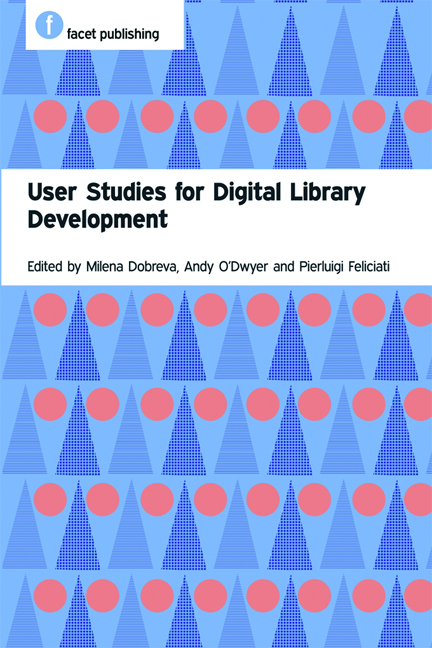Book contents
- Frontmatter
- Contents
- Preface
- Acknowledgements
- Abbreviations
- Glossary
- 1 Introduction: user studies for digital library development
- PART 1 SETTING THE SCENE
- PART 2 METHODS EXPLAINED AND ILLUSTRATED
- PART 3 USER STUDIES IN THE DIGITAL LIBRARY UNIVERSE: WHAT ELSE NEEDS TO BE CONSIDERED?
- PART 4 USER STUDIES ACROSS THE CULTURAL HERITAGE SECTOR
- PART 5 PUTTING IT ALL TOGETHER
- 24 And now … to the brave real world
- Index
24 - And now … to the brave real world
from PART 5 - PUTTING IT ALL TOGETHER
Published online by Cambridge University Press: 08 June 2018
- Frontmatter
- Contents
- Preface
- Acknowledgements
- Abbreviations
- Glossary
- 1 Introduction: user studies for digital library development
- PART 1 SETTING THE SCENE
- PART 2 METHODS EXPLAINED AND ILLUSTRATED
- PART 3 USER STUDIES IN THE DIGITAL LIBRARY UNIVERSE: WHAT ELSE NEEDS TO BE CONSIDERED?
- PART 4 USER STUDIES ACROSS THE CULTURAL HERITAGE SECTOR
- PART 5 PUTTING IT ALL TOGETHER
- 24 And now … to the brave real world
- Index
Summary
Introduction
After looking at all the methods and examples presented in this book, one could feel overwhelmed by the multiplicity of options available, and also by the plethora of questions raised and with no definitive guidance provided. Having more questions than answers is definitely one of the challenges in the domain of user studies, but to explore and work in a domain that allows for initiative and discovery is a great opportunity. Looking at ongoing research one might also get an impression of fragmentation – for example, because various types of users are studied in different situations without building a coherent picture. It is indeed inevitable that particular studies are done and will continue to be done looking at specific cases and trying to answer very clearly defined questions within a limited context. Unfortunately, the projectdriven culture in which most of us work does not accommodate work with users, at best. We have seen many projects, for example, where the definition of user requirements is done at the same time as the system architecture is being developed and, instead of informing the system architecture, becomes an activity that could actually contradict the technological solutions selected by developers, or that could be seen as simply ‘ticking the user consultation box’. We hope that this book will start to help in fostering a change towards greater coherence and comparability in future user studies!
This final chapter aims to help readers to decide what type of a study could be of best help in a particular situation.
Designing a study
The first question to ask is ‘What stage is my project at, and how exactly might user studies be helpful?’. We believe that there are several stages to go through.
Stage 1: Determine the type of user involvement
The various roles that users can play at different development stages are summarized in the following sections.
Front-end involvement
Frontend involvement of users is used to identify typical user groups, their needs and expectations and accessibility issues. User studies aim to define in detail what user needs and expectations should be accommodated in the digital library (DL). In addition to information gathered by doing research on similar solutions and technological capabilities, this stage needs to build a clear picture of the target users.
- Type
- Chapter
- Information
- User Studies for Digital Library Development , pp. 247 - 254Publisher: FacetPrint publication year: 2012



